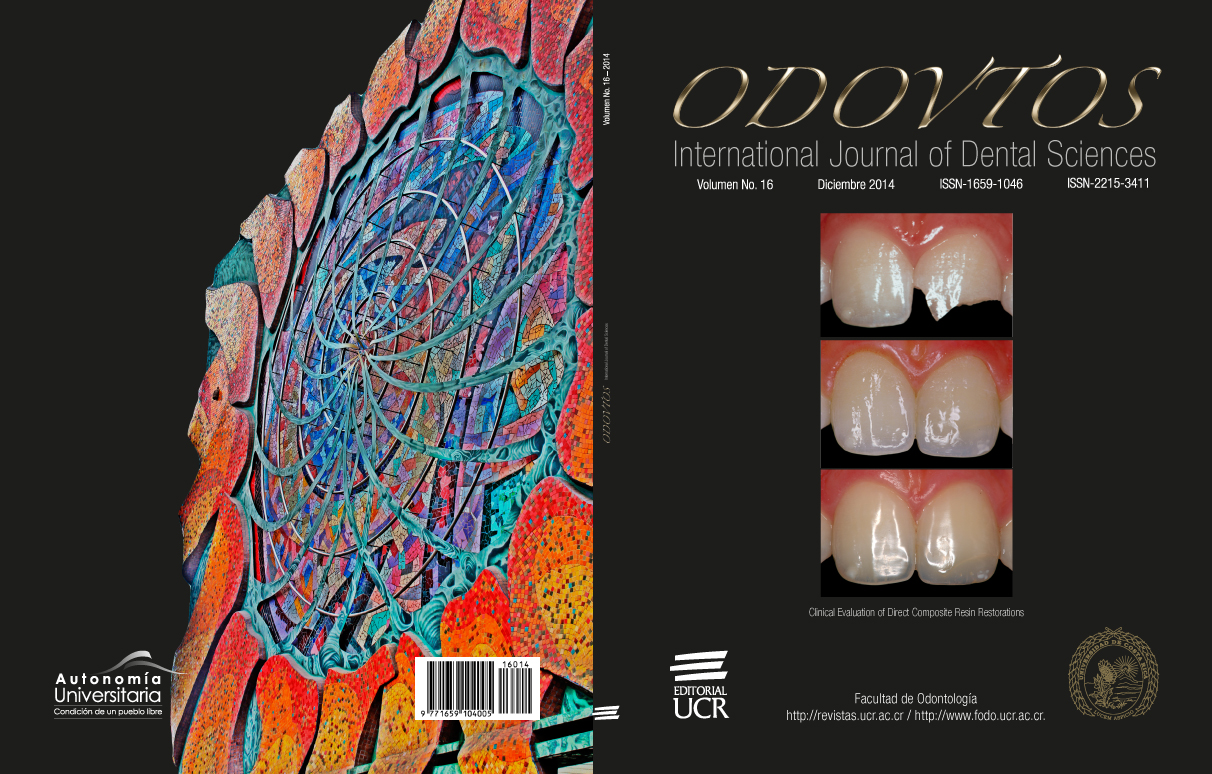Abstract
The objective of this study was to evaluate the marginal seal effectiveness and microleakage of a pit and fissure sealant containing silver nanoparticles (AgNPs). An experimental in vitro study was carried out using 40 extracted temporary molars without caries or incipient caries. These molars were divided into two groups: Group A (20 molars), to which a silver nanoparticle-containing sealant was applied, and Group B (20 molars), to which a conventional sealant was applied. The marginal seal and microleakage were evaluated. No significant differences in the marginal seal or microleakage were noted between the silver nanoparticle-containing sealant and the conventional sealant.The addition of AgNPs does not alter the adhesion or resistance of the sealant.
References
Ahovuo-Saloranta, A., Forss, H., Walsh, T., Hiiri, A., Nordblad, A., Mäkelä, M., & Worthington H.V. (2013). Sealants for preventing dental decay in the permanent teeth. Cochrane Database Systematic Reviews,doi: 10.1002/14651858. CD001830.
Asselin, M.E., Fortin, D.,Sitbon, Y., &Rompré P.H. (2008). Marginal microleakage of a sealant applied to permanent enamel: evaluation of 3 application protocols. Pediatric Dentistry,30:29-33.
Barclay, C.W., Boyle, E.L., Williams, R., & Marquis, P.M. (2002).The effect of thermocycling on five adhesive luting cements. Journal of Oral Rehabilitation,29:546-552.
Beauchamp, J., Caufield, P.W., Crall, J.J., Donly, K., Feigal, R., Gooch, B., Ismail, A., Kohn, W., Siegal, M., &Simonsen, R.; American Dental Association Council on Scientific Affairs.(2008). Evidence-based clinical recommendations for the use of pit-and-fissure sealants: a report of the American Dental Association Council on Scientific Affairs. Journal of American Dental Association, 139:257-268.
Deery, C. (2013). Caries detection and diagnosis, sealants and management of the possibly carious fissure. British Dental Journal,214:551-557.
Frankenberger, R., Pashley, D.H., Reich, S.M., Lohbauer, U., Petschelt, A., &Tay, F.R. (2005). Characterisation of resin-dentine interfaces by compressive cyclic loading. Biomaterials,26:2043-2052.
Grande, R.H., Ballester, R., Singer, Jda. M., & Santos, J.F. (1998). Microleakage of a universal adhesive used as a fissure sealant. American Journal of Dentistry, 11:109-113.
Hernández-Sierra, J.F., Galicia-Cruz, O., Angélica, S.A., Ruiz, F., Pierdant-Pérez, M., & Pozos- Guillén, A.J. (2011). In vitro cytotoxicity of silver nanoparticles on human periodontal fibroblasts. Journal of Clinical Pediatric Dentistry,36:37-41.
Hernández-Sierra, J.F., Ruíz, F., Castanedo- Cázares, J.P., Martinez-Ruiz, V., Mandeville, P., Pierdant-Pérez, M., Gordillo-Moscoso, A., & Pozos-Guillén, Ade J. (2010(a)). In vitro determination of the chromatic effect of a silver nanoparticles solution linked to the Gantrez S-97 copolymer on tooth enamel. Journal of Clinical Pediatric Dentistry,35:65-68.
Hernández-Sierra, J.F., Ruiz, F., Pena, D.C., Martínez-Gutiérrez,F.,Martínez,A.E.,Guillén,A. deJ.,Tapia-Pérez,H.,&Castañón,G.M.(2008). The antimicrobial sensitivity of Streptococcus mutans to nanoparticles of silver, zinc oxide, and gold. Nanomedicine: Nanotechnology, Biology, and Medicine,4:237-240.
Hernández-Sierra, J.F., Salas-López, E.K., Martínez- Gutiérrez, F., Ruíz, F., Pierdant-Pérez, M., Mandeville, P., & Pozos-Guillén, A.J. (2010(b)). Bactericidal capacity of silver nanoparticles associated with Gantrez S-97 on Streptococcus mutans. Journal of Clinical Pediatric Dentistry, 35:183-185.
Kane, B., Karren, J., Garcia-Godoy, C., & Garcia- Godoy, F. (2009). Sealant adaptation and penetration into occlusalfissures. American Journal of Dentistry, 22:89-91.
Khanna, R., Pandey, R.K., Singh, N., & Agarwal, A. (2009). A comparison of enameloplasty sealant technique with conventional sealant technique: a scanning electron microscope study. Journal of the Indian Society of Pedodontics and Preventive Dentistry,27:158-163.
Kostenko, V., Lyczak, J., Turner, K., & Martinuzzi, R.J. (2010). Impact of silver-containing wound dressings on bacterial biofilm viability and susceptibility to antibiotics during prolonged treatment. Antimicrobial Agents and Chemotherapy, 54:5120-5131.
Koyuturk, A.E., Kusgoz, A., Ulker, M., & Yesilyurt, C. (2008). Effects of mechanical and thermal aging on microleakage of different fissure sealants. Dental Materials Journal,27:795-801.
Kumar, A., Vemula, P.K., Ajayan, P.M., & John, G. (2008). Silver-nanoparticle-embedded antimicrobial paints based on vegetable oil. Nature Materials,7:236-241.
Lobo, M.M., Pecharki, G.D., Tengan, C., da Silva, D.D., da Tagliaferro, E.P., & Napimoga, M.H. Fluoride-releasing capacity and cariostatic effect provided by sealants. (2005). Journal Oral Science,47:35-41.
Montanari, M., Pitzolu, G., Felline, C., & Piana, G. Marginal seal evaluation of different resin sealants used in pits and fissures. An in vitro study. (2008). European Journal Paediatric Dentistry, 9:125-131.
Nikaido, T., Kunzelmann, K.H., Chen, H., Ogata, M., Harada, N., Yamaguchi, S., Cox, C.F., Hickel, R., & Tagami, J. (2002). Evaluation of thermal cycling and mechanical loading on bond strength of a self-etching primer system to dentin. Dental Materials, 18: 269-275.
Pardi, V., Sinhoreti, M.A., Pereira, A.C., Ambrosano, G.M., & Meneghim,Mde C. (2006). In vitroevaluation of microleakage of different materials used as pit-and-fissure sealants. Brazilian Dental Journal, 17:49-52.
Singh, S., & Pandey, R.K. (2011). Anevaluation of nanocomposites as pit and fissure sealants in child patients. Journal of the Indian Society of Pedodontics and Preventive Dentistry,29:294-299.
Totaro, P., & Rambaldini, M. (2009). Efficacy of antimicrobial activity of slow release silver nanoparticles dressing in post-cardiac surgery mediastinitis. Interactive Cardiovascular and Thoracic Surgery,8:153-154.
Wahab, F.K., Shaini, F.J., & Morgano, S.M. (2003). The effect of thermocycling on microleakage of several commercially available composite Class V restorations in vitro. Journal of Prosthetic Dentistry,90:168-174.

